Manchesters
Breed History
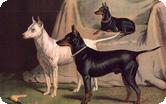 As with most purebred dogs, the Manchester's exact origins are not known. The word "terrier" is derived from Latin and means "of the ground" referring to the dogs ability to chase vermin underground in their dens although this has never been a function for which the Manchester Terrier, itself, has been noted. The "Black and Tan" terrier is credited as being the oldest, first recognized terrier. A historic painting dating back to the beginning of the 16th Century, "The Hour of the Virgins" depicts a smooth coated dog which resembles today's Manchester. It's apparent that both a rough and smooth coated version of the Black and Tan co-existed along with the now extinct White English Terrier.
As with most purebred dogs, the Manchester's exact origins are not known. The word "terrier" is derived from Latin and means "of the ground" referring to the dogs ability to chase vermin underground in their dens although this has never been a function for which the Manchester Terrier, itself, has been noted. The "Black and Tan" terrier is credited as being the oldest, first recognized terrier. A historic painting dating back to the beginning of the 16th Century, "The Hour of the Virgins" depicts a smooth coated dog which resembles today's Manchester. It's apparent that both a rough and smooth coated version of the Black and Tan co-existed along with the now extinct White English Terrier. 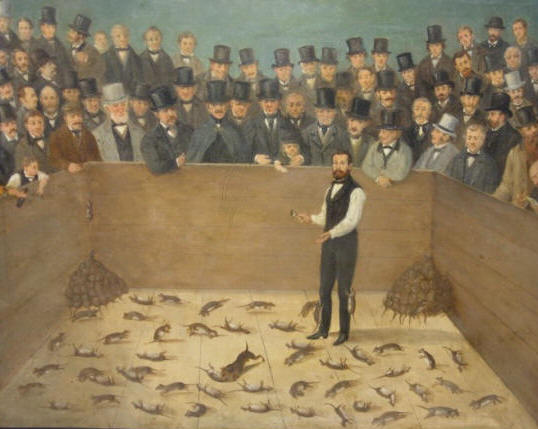 Black and Tan terriers, as the Manchester was known until the second half of the 19th century, in England, were prized for their ability to kill rats in "pits." This was a form of blood-sport later outlawed where a dog was placed in a pit with a number of rats and bets were placed as to which dog could kill a specific number the fastest or which dog could kill the most rats in a set period of time. In the days before modern medicine and sanitation, rats posed a significant public health risk. The "sport" or rat-killing in pits grew out of the necessity of killing disease carrying vermin. It served as a form of entertainment for those living in newly industrialized urban areas.
Black and Tan terriers, as the Manchester was known until the second half of the 19th century, in England, were prized for their ability to kill rats in "pits." This was a form of blood-sport later outlawed where a dog was placed in a pit with a number of rats and bets were placed as to which dog could kill a specific number the fastest or which dog could kill the most rats in a set period of time. In the days before modern medicine and sanitation, rats posed a significant public health risk. The "sport" or rat-killing in pits grew out of the necessity of killing disease carrying vermin. It served as a form of entertainment for those living in newly industrialized urban areas.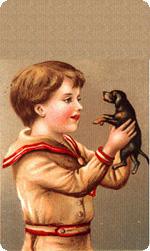 It appears that the smaller dogs were most used in the rat pits with a 5lb dog named "Tiny" being credited as the greatest ratter of the era. Smaller dogs received a 'handicap' from the odds-makers of the day, making them a better bet for those gambling on the contests. Later, the Victorian craze for miniaturization and Toys weighing 1-2lbs brought about many health problems. The Toy variety today is larger, and both varieties are quite healthy. Toys range from about 7-12lbs; Standards from 12-22lbs for show.
It appears that the smaller dogs were most used in the rat pits with a 5lb dog named "Tiny" being credited as the greatest ratter of the era. Smaller dogs received a 'handicap' from the odds-makers of the day, making them a better bet for those gambling on the contests. Later, the Victorian craze for miniaturization and Toys weighing 1-2lbs brought about many health problems. The Toy variety today is larger, and both varieties are quite healthy. Toys range from about 7-12lbs; Standards from 12-22lbs for show.
There is speculation that the Manchester was crossed with Whippets to give extra speed. When brought to the United States, Manchesters were used to course small game. Manchesters are also depicted in paintings as being carried by riders to be "in at the kill" at fox hunts and gained the name "The Gentleman's Terrier" because of that function.
Following the bans on bloodsports and ear-cropping in the UK, the 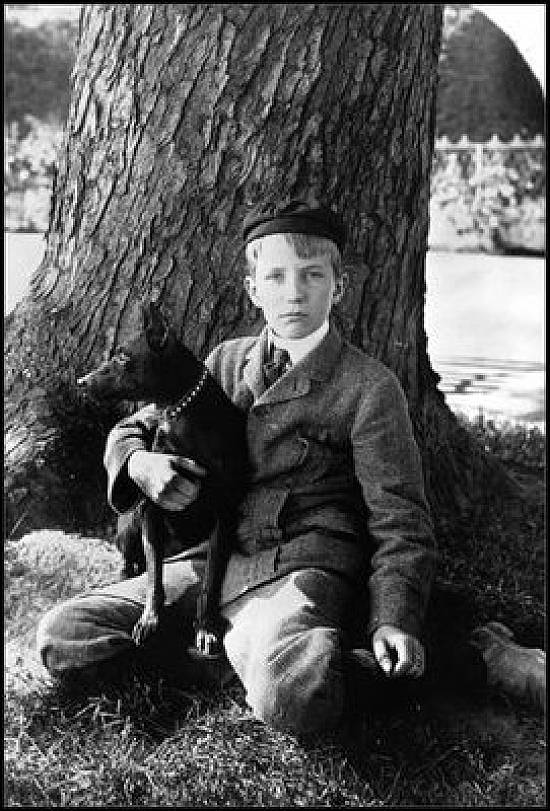 Manchester Terrier saw a significant decline in popularity in the country of origin. Fortunately, dogs had already been exported to North America where they thrived. Teddy Roosevelt owned a Manchester Terrier named "Blackjack" who lived in the White House. In 1928, the breed was split into two in England becoming the "Manchester Terrier" and "English Toy Terrier (Black and Tan), as it remains today. A similar split occurred in North American but on a less formal basis with interbreeding still allowed.
Manchester Terrier saw a significant decline in popularity in the country of origin. Fortunately, dogs had already been exported to North America where they thrived. Teddy Roosevelt owned a Manchester Terrier named "Blackjack" who lived in the White House. In 1928, the breed was split into two in England becoming the "Manchester Terrier" and "English Toy Terrier (Black and Tan), as it remains today. A similar split occurred in North American but on a less formal basis with interbreeding still allowed.
Following World War II, the Manchester Terrier on both continents was in trouble while the Toy Terrier thrived. In the UK, there were fewer than 11 registered Manchester Terriers only 7 of which were of breeding age. In the US, the breed club was without formal representation. The fanciers on both continents along with AKC and the KC in England took different paths in restoring the breed. In the US and Canada, the Manchester Terrier and Toy Terrier were recombined into one breed, the Manchester Terrier with two varieties, Toy and Standard. In England, two dogs were imported from the US and limited breeding was allowed with ETT's to broaden the gene pool.
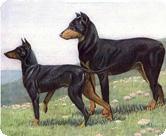 The "Black and Tan" is credited with being the source breed for most terriers. The Manchester in particular is credited with being one of the main foundations for the Doberman Pinscher. What exactly Herr Doberman used in his "recipe" for that dog is very much a mystery, but there is clearly shared lineage between the two breeds.
The "Black and Tan" is credited with being the source breed for most terriers. The Manchester in particular is credited with being one of the main foundations for the Doberman Pinscher. What exactly Herr Doberman used in his "recipe" for that dog is very much a mystery, but there is clearly shared lineage between the two breeds.

